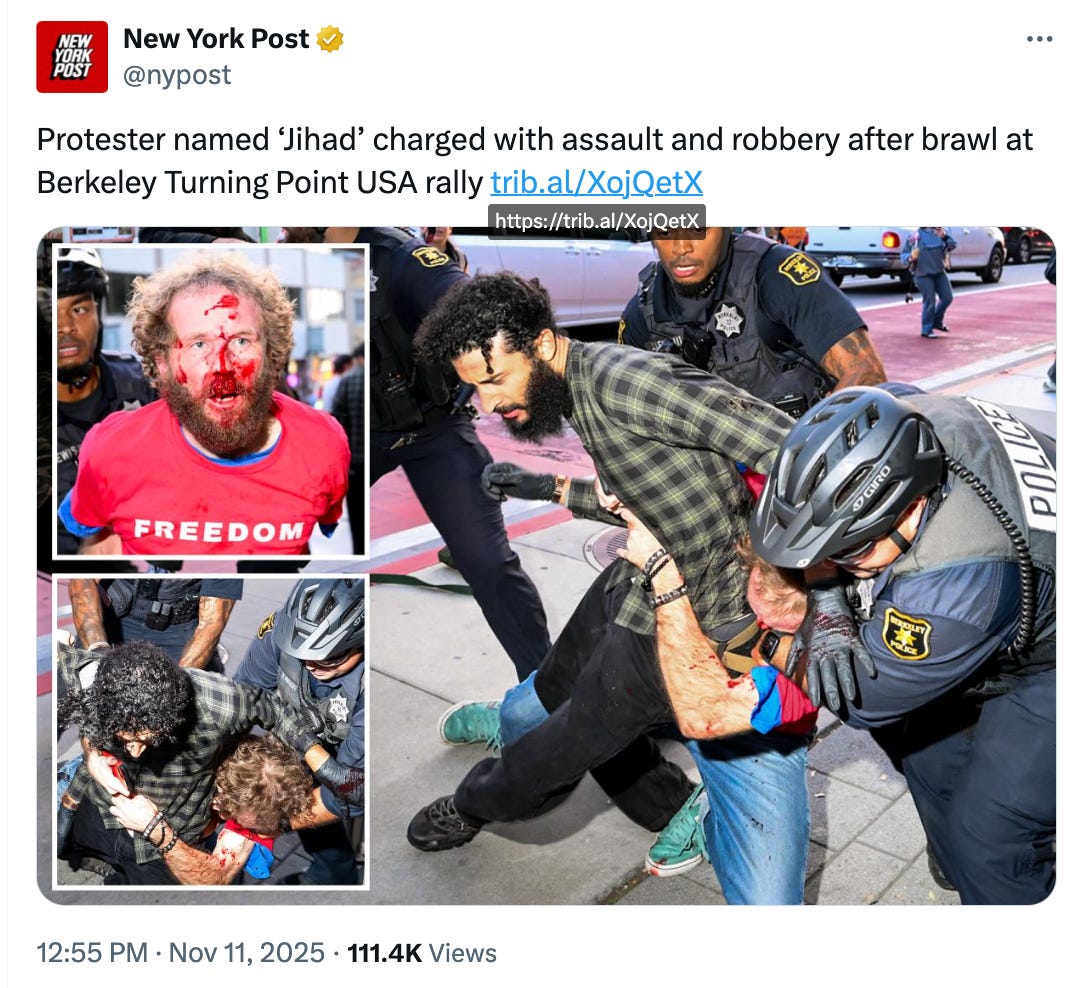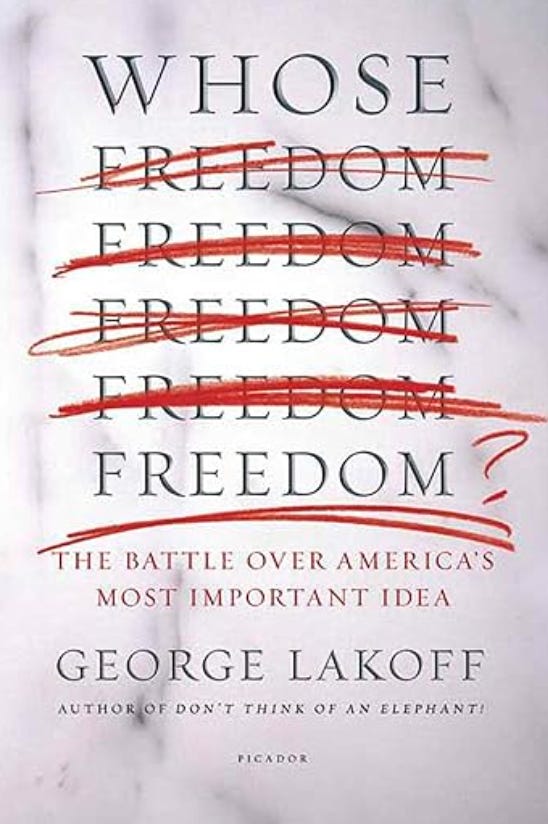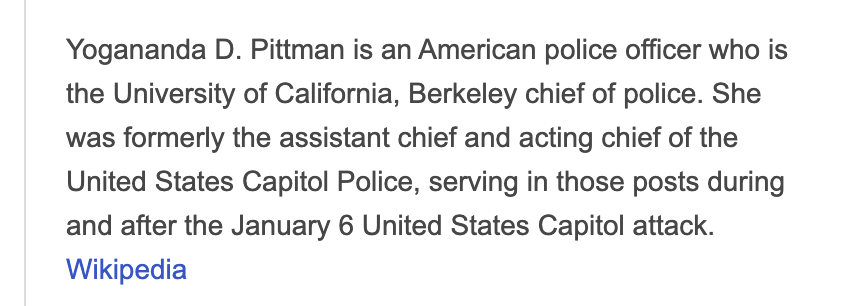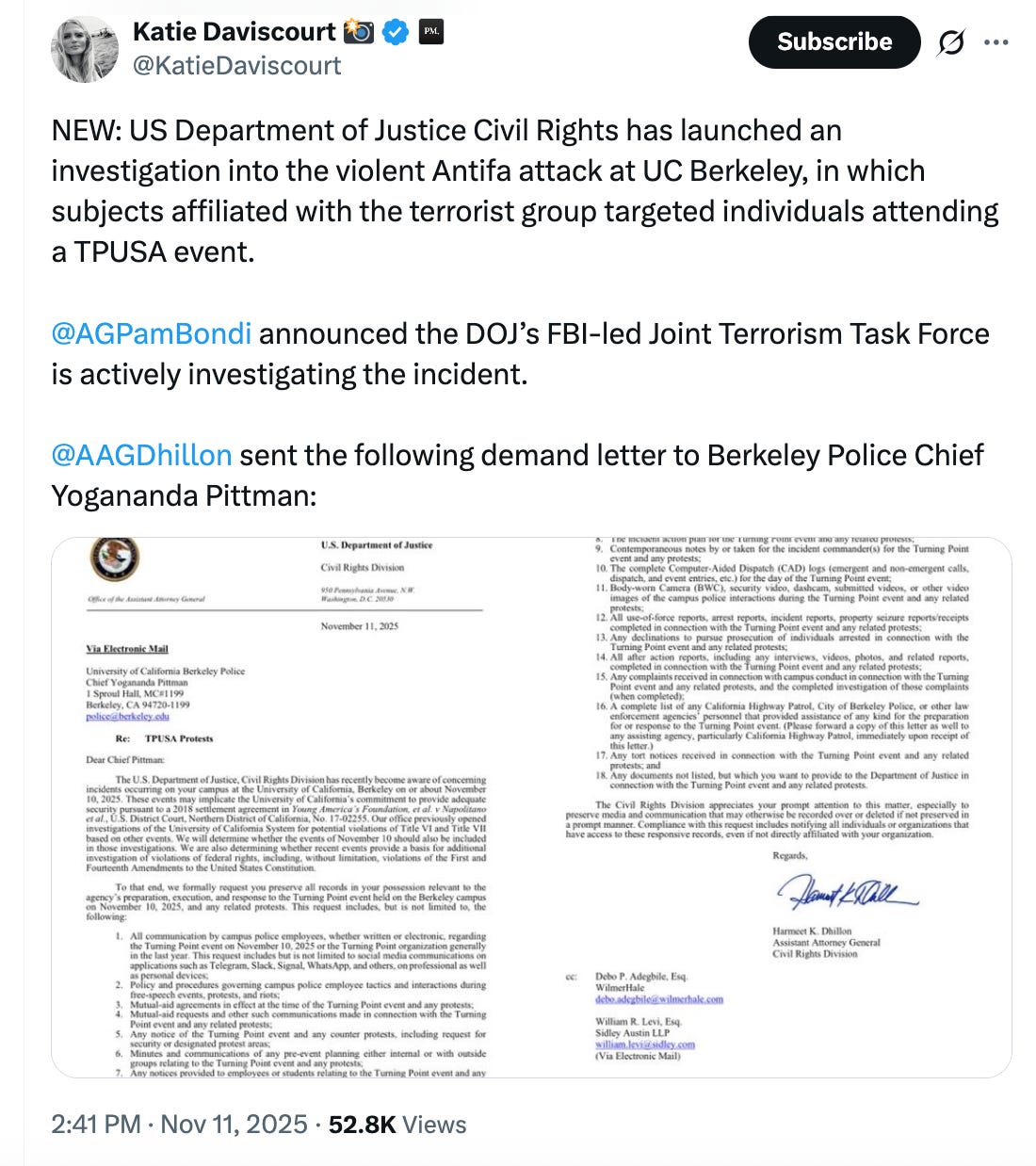Berkeley: Can We Talk?
Blue City logic is that their violence is speech, but your speech is violence. Make it make sense.
Peter Boghossian and James Lindsay’s 2019 How to Have Impossible Conversations (a very practical guide) diagnosed a sickness in our culture: intolerance for opposing opinions. And it offered a very simple cure: learn to listen. It augmented that advice with techniques to engage people on difficult issues instead of turning them off or turning them away. It wasn’t ideological; it was meant to bridge divides.
Six years and one assassination later, the project seems so quaint.
By now, you may have seen the footage, the most horrible shot that killed Charlie Kirk September 10th, 2025, and two months later, November 10th, another bloodied face in a Freedom t-shirt that has come to represent the latest Battle of Berkeley.1 The latter was Monday’s final stop on the fall Turning Point USA tour — which had become a memorial for Charlie Kirk and his attempt to engage adversarial students in conversation. People lined up to see comedian Rob Schneider offer a few jokes and say a few words about freedom, along with Christian apologist Frank Turek, Shakespeare scholar Andrew Doyle, and the aforementioned philosopher Peter Boghossian, among others. Two thousand people had secured tickets. Only one thousand were allowed into the building for some reason. But while those thousand entered and exited Zellerbach Hall, they were treated to a wild scene of explosions, smoke bombs, racial slurs, rabid name-calling, viscous goop sprayed on them from a nearby building, bottles thrown at heads — and cameras trained on their movements.
For the criminal act of: Listening.
What did we hear? Well, Rob Schneider had a great joke involving the Saturday Night Live 50th celebration that used Schneider’s impressionist skills as Robert De Niro for the punch line! (And yes, the moral of the story to that joke was, I believe: “Love your enemies.”) We heard Frank Turek speaking about using a kind of media literacy technique (motivations) to understand the gospels. And we heard very earnest questions from the audience, including one from a female student who wanted tips on becoming a comedian. Not everything was political. And it was most certainly not politically “correct.”
High crimes!
The audience was introduced to the idea of “grace” — a Christian concept — that acknowledges that though we as humans can never be perfect, we are redeemed, if we accept the offer. And, on the other side of the spectrum, atheist Peter Boghossian broke down some of his methods for personal engagement.
See: We can agree to disagree — and we can hear each other out. At least inside the building.
Outside, on the Berkeley campus — the so-called “birth place” of the Free Speech Movement2 — there wasn’t speaking so much as shouting with bullhorns and shaking of traffic barriers.
Little known is that Berkeley didn’t just invent the Free Speech Movement with Mario Savio’s speech in front of Sproul Hall in 1964, it also invented the Anti-Free Speech Movement, a.k.a. speech codes, bias response teams and the redefinition of words as weapons in the late 80s and early 90s.
UC Berkeley linguist George Lakoff was a regular on the book and NPR-interview circuit popularizing an idea I remember as promoting less of a “freedom to” (do things) attitude and more of a “freedom from” (oppression) one. Who and what defines this “freedom” and why does the switcheroo matter? Steven Pinker’s review of Lakoff’s Whose Freedom? breaks it down better than I can. Suddenly it was not individual liberty anyone on the left cared about but individual safety.
Who could have guessed that from Free Speech to Speech Codes we would move even further — to Enforced Speech and the Era of Pronouns. Not speech that is yours, mine, and ours, but only Theirs. Formal agreement with 100 percent of their opinions is not optional, it’s a requirement. The grammar will not make sense but it will be policed.
They and theirs were the ones outside who, in the name of “Free Speech,” were blocking the exits and attempting to trap listeners inside. The “conversation” with them was, indeed, impossible — as it gets when emotion rules the day. As Rob Schneider was saying in the opening of his speech to the audience inside:
“I love Berkeley and I mean that. I love the history of Berkeley. And I believe what is happening now is a blip. It is an intolerant blip. … We are in an age of emotion. When historians look back … and ask what was that all about? … If you give in to those desires and passions; if you use that before your sense of reason and rationality and logic then you can be manipulated — like the people outside this building right now. They’re coming from a place not of rationality, they’re coming from a place of emotion. That’s tough.”
It was also, frankly, astounding, after an assassination like Kirk’s, that a group with all the uniformed regalia of the recently identified-as-terrorist Antifa came armed and ready for physical, militant confrontation. And that the city felt this well known-in-advance gathering could be managed simply with a thin blue line of local law enforcement (University security? local police?) between these too-easily-triggered masses and their targets of scorn.
Seems to be improper foresight there from many, including the City of Berkeley Chief of police:
But apparently, the U.S. Department of Justice is on it:
Freedom of speech does mean freedom to assemble and freedom to be heard above and beyond the hecklers — I think. Dressed as those hecklers were in their head-to-foot 2020 Handmaid’s Tale outfits — N-95 masks and keffiyehs — chanting like indoctrinated cultists, you couldn’t help but feel empathy for them. In thrall to suspect professors who certainly do not have their best interests at heart, screaming in frustration that people with opposing views exist, they seemed to have hit a dead end. I hope they could see from our smiles — even as we ducked their bottles — that any time they are ready to have that Impossible Conversation, we are game.
This article is presented as commentary, though I was present at the event. I experienced the entry and exit intimidations and, while inside, overheard security in discussion with organizers about continued issues outside the venue (bottles, backfires). I scanned first-person reporting after the event (drone and street view) to get a sense of the assault on the t-shirt vender and other details out of my view.
It’s not even a memory anymore, the Free Speech movement. I and friends were running / jogging through the Berkeley Free Speech Movement Cafe and Plaza without face masks in fall of 2021. No, the students weren’t celebrating free speech at that point, from the aghast faces we encountered. They weren’t even celebrating free “breath.”







I was hanging out with this t-shirt vendor just eating a bratwust and chatting before the event. he was wearing a crucifix around his neck. The media is reporting that a "necklace" was stolen. In fact what happened was an islamic radical wearing a mask and gloves trying to conceal his identity ripped a crucifix off a christian. the christian ran after him trying to recover it and the thief beat the christian. the police officers initially detained the christian (this is the photo that is widely spread).
Facts are important to understand what is happening here. Use real words and real facts.
If speech is violence and violence is speech, then we are truly in the Orwellian nightmare.